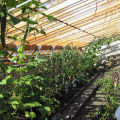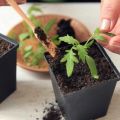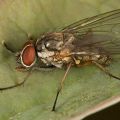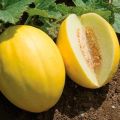How to get rid of midges in indoor flowers with chemical and folk remedies
If midges appear in indoor flowers, you need to find the right way to get rid of them. In order for the selected composition to work, it is necessary to determine the type of insect and the stage of damage to the flower. A whole list of unfavorable factors leads to the appearance of pests. First of all, it is necessary to make adjustments to the main points of departure. The drugs are sold ready-made, or the composition is prepared independently according to folk recipes.
Indoor midges
There are over 1500 species of flower midges. Several of them are often found in home flowers. To save the plant, you need to start fighting as soon as the first signs appear.
Fruit flies
Fruit flies are small fruit flies with a small body no more than 2.4 mm long, yellow-brown in color. The eyes have a deep reddish tint.
In the house, pests start in food debris, rotten vegetables and fruits. They often settle in flowers and suck out all the juices from the plant. The appearance of Drosophila is also associated with poor-quality soil.
Sciarids
Sciarids are small flying pests that settle at the root of flowers such as aloe, orchid, ficus, violet, azalea. The adult has an elongated black body no more than 1.4 mm long.
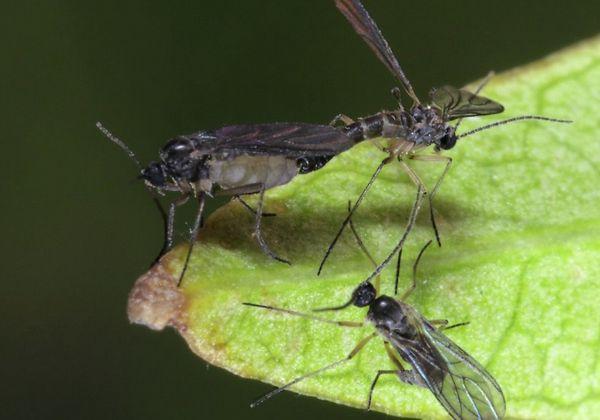
The female lays eggs in the soil, between the root branches. Sciarid larvae look like white small worms up to 4.5 mm long; a black spot is clearly visible in the head part.
Whiteflies
Whiteflies are small moths, no more than 3 mm. The body and wings are white, and powdery pollen is visible on the surface. Most often, the whitefly appears on plants that have soft leaves (for example, begonia, fuchsia). The pest sucks the juices from the tissues of the flower, which becomes the cause of its death.
Reasons for the appearance
The appearance of midges at home is associated with many adverse factors:
- Improper watering is the main reason. Frequent and abundant soil moisture leads to active reproduction of insects.
- Another reason is transplanting a flower into a larger pot. During irrigation, water is retained in the lower layer of the soil. Therefore, if the roots of the plants do not reach the bottom of the pot, humidity rises. As a result, favorable conditions are created for the development of parasites.
- Improper feeding, for example, excess organic matter contributes to the appearance of midges. It is also not recommended to use tea leaves for watering.
There are many other unfavorable factors that lead to the appearance and spread of parasites.
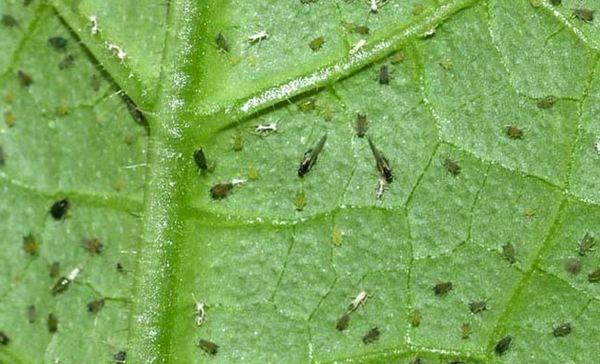
Purchased land
In low-quality store soil, the larvae of various pests can be found. Under favorable conditions, new individuals appear from them. Therefore, in order not to start flies, the soil is disinfected before planting. It is spilled with boiling water, calcined in the oven or poured with a solution based on potassium permanganate.
Fly through the window
There is a high probability that midges flew through a window, door or through a ventilation passage from another apartment. Insects immediately find a suitable plant for them and settle in it. To prevent flies from flying into the house, it is advisable to hang a mosquito net with small cells on the windows.
Wet, overflowing soil
Flies often appear in domestic plants due to improper watering. In warm and humid conditions, eggs hatch faster. Therefore, it is important to consider the dosage and the time interval between waterings. In addition, each type of flower needs a certain amount of moisture. For irrigation, use only warm, settled water.

Damage caused
Midges slow down the growth and development of plants, in some cases they can lead to their death:
- Moshkara leads to soil compaction, as a result of which air and moisture penetrate poorly to the roots.
- Leaves begin to wilt, turn yellow, dry and fall off.
- Insects can carry various diseases that are dangerous to flowers.
For humans, flower insects are not dangerous. They do not bite and do not tolerate diseases that are dangerous to human health.
Control methods
As soon as the pest has been detected, rescue actions must be started:
- the infected flower is moved to another place, away from other plants;
- it is advisable to transplant a flower into a new, treated soil;
- before transplanting, the roots of the plant are quickly washed under running water;
- it is better to dry the soil; for this purpose, watering is not carried out for several days.
Chemical and folk remedies will help to quickly destroy the midges.
Folk remedies
Folk methods of getting rid of insects are considered safe and effective. It is recommended to set traps or prepare soil and foliage formulations.
Allow to dry 2 cm layer
If you dry the ground, then there is a high probability that the midges will die. It is enough to wait for the soil to dry to a depth of 20 mm (insect larvae do not live deeper than 2.5 cm). Dry, damaged soil layer is replaced with new soil. All flying individuals must be caught using homemade traps.
Catch adult midges
Established traps will help to catch adults. A vacuum cleaner is also used.
Traps
Midge catching devices are available at the store, but they are easy to make yourself. It is enough to use any material soaked in sweet syrup.

Special
Intrusive flies get into the eyes, into the mouth. To catch them, all you have to do is buy duct tape from the store and hang it around the room. The tape is impregnated with a special solution, which attracts with its smell.
Homemade
It's easy to make the trap yourself. There are many options for their manufacture:
- Cut long strips of fabric or paper, soak them with sweet compounds (jam, honey) and hang them near the window.
- You can make a trap from a plastic bottle. It is necessary to cut off the bottom of the bottle, put an apple core inside. The upper part of the cut part is covered with foil and small holes are made. Through the holes, midges easily penetrate into the container, but they cannot get out back.
- Some types of midges can be caught using potatoes.The potatoes are cut in half. Half are placed in a flower pot. After a while, the larvae will stick around the fresh cut of the potato.
Vacuum cleaner
When the pests are sitting on the leaves of flowers, you can try to suck them in with a vacuum cleaner. This method should be repeated several times and is best combined with other methods of dealing with flyers. The bag should be discarded after each procedure.
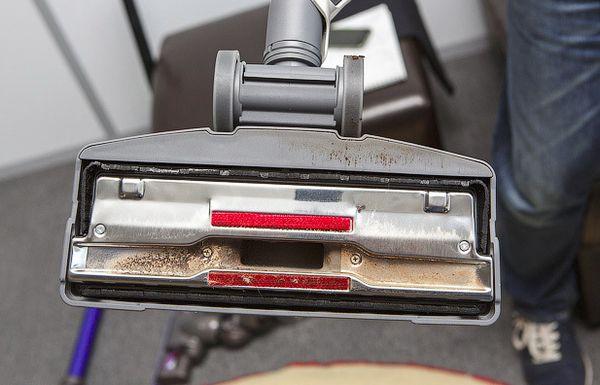
Work the land
If pests are found, the soil should be watered with special solutions.
Garlic infusion
Garlic has a detrimental effect on many insects. Garlic infusion is useful for work:
- chop the cloves of three heads of garlic;
- the gruel is poured with a liter of boiling water;
- so that the component is infused, leave for 3.5 hours;
- then the composition is filtered;
- the prepared solution is poured over the damaged soil and the leaves are sprayed.
Potassium permanganate solution
If midges are found in flowers, watering with potassium permanganate will help. A small amount of potassium permanganate is diluted in water (the water should turn pink) and the plant is watered. So that the pests do not appear again, the treatment is carried out two days later.
Soap solution
A soap solution will help to remove indoor pests:
- grind laundry soap;
- soap shavings (25 g is enough) are dissolved in 900 ml of boiling water;
- the leaves are treated with a ready-made solution and the soil around the flower is watered.
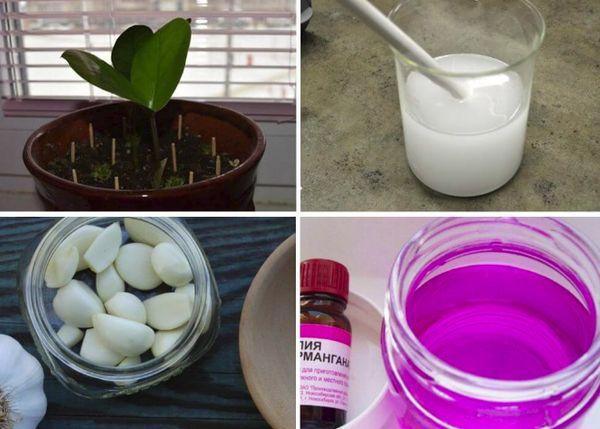
Sulfur
Match sulfur repels pests:
- matches (gray down) deepen into the ground around the flower;
- moisten the place around each match;
- after a day, the matches are changed to new ones, since the sulfur quickly dissolves.
After 3-4 updates of matches, midges should disappear.
Anthelmintic drugs
Any anti-helminth remedy purchased at a pet store (for example, Pirantel) is suitable for tillage. The solution is prepared according to the recommendations specified in the instructions. To kill all insects, the plant is watered with the solution twice with an interval of six days.
Toxic greenhouse
A toxic greenhouse is easy to make. The method is efficient and economical.
Drain the soil
First, they wait for the soil to dry out after the next watering.

Loosen the ground
The next step is to gently loosen the topsoil.
Put the pot in a bag and spray a little "Dichlorvos"
Take a large plastic bag and place the whole flower inside. All actions are carried out carefully so that the branches of the plant do not crumple or break:
- Dichlorvos is sprayed inside the package.
- In this state, the flower is left for 3.5 hours. During this time, all individuals manage to die.
- The flower is rearranged away from other plants and the bag is removed. Return to the old place is carried out in 12 days.
"Dichlorvos" can be replaced with "Raptor", "Raid" or solutions made on the basis of such insecticides as "Karbofos", "Thunder", "Aktara", "Actellik".
Hang up traps
Made traps are hung near the window. They will help to catch adults that did not get inside the bag.
Repeat after 8 days
To prevent midges from appearing again, the whole procedure with spraying "Dichlorvos" and hanging adhesive tape is repeated again.

How to remove a whitefly
It is more difficult to remove the whitefly from home flowers, since it is resistant to many compounds. Low temperatures and drought are unfavorable conditions for its development. Therefore, the plant should be moved to a cool place and not watered until the soil is completely dry.
Using traps
You need to hang traps near the windowsill that will help catch annoying insects.
Leaf washing
After most of the flying pests fall into the trap, you need to rinse all the branches and leaves of the plant. The flower is placed in the bathroom and the leaves are washed from the remaining midges and their larvae.
Spraying plants with a solution of systemic insecticides
The next step is to treat the soil and leaves with insecticides. The solution is poured over the soil and sprayed on the green part of the plant.
"Actellik"
It will be possible to destroy midges with the help of the Actellik insecticide. The death of pests begins from the first minutes after treatment. To prepare the solution, it is necessary to dilute the ampoule with the drug with two liters of water. Ventilate the area after spraying.
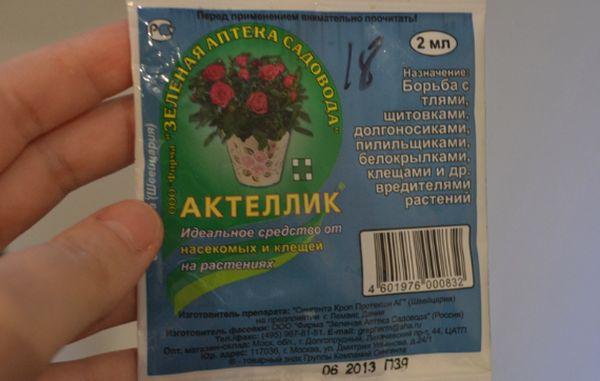
"Confidor"
Effective drug "Confidor" helps to cope with many pests of indoor plants. Only 2 g of the substance needs to be dissolved in 9 liters of water. During the month, the treatment is repeated at intervals of 4 days. This is done in order to destroy all earth larvae.
"Mospilan"
Insecticide allows you to quickly forget about the existence of midges in the apartment. To prepare the solution, you need to dissolve 1 g of the drug in two liters of water.
"Fufanon"
The insecticide "Fufanon" helps to cope well with insects. In one liter of water, dilute 1 ml of the drug. The finished solution is poured into a container with a spray. Spraying is carried out on the leaves on both sides. A day later, the flower pot is put in its original place.
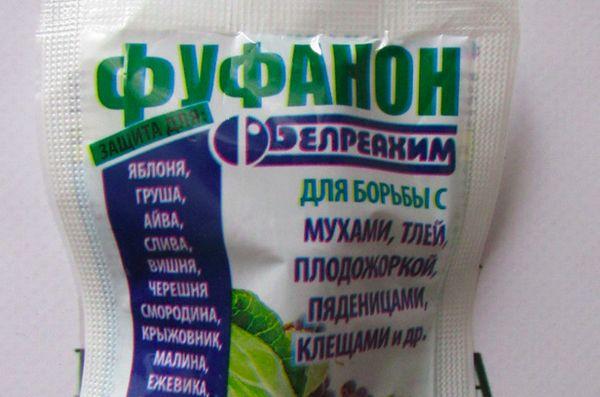
Toxic greenhouse
Effective use of toxic greenhouse:
- They are waiting for the soil to dry out.
- Loosening of the soil is carried out.
- The pot is covered with a bag so that it covers all the branches.
- A small amount of the selected insecticide ("Dichlorvos", "Thunder", "Aktara", "Actellik") is sprayed onto the ground and the inner walls of the package. It is important not to allow the composition to get on the green part of the plant.
- The bag is removed after 3.5 hours.
A toxic greenhouse contributes to the death of not only adults, but also larvae.
Transfer
If there are many larvae in the soil, it is better to transplant the flower into fresh, cultivated soil. The soil is loosened and the flower is pulled out, being careful not to damage the roots. All root branches are washed and cleaned from contaminated soil with a brush. Fertilization is recommended after transplanting.
Prevention
Preventive measures will prevent the reappearance of insects:
- it is important to observe the watering regime;
- the next day after watering, you need to loosen the soil;
- before planting, the ground must be calcined, poured with boiling water or other disinfectant;
- you need to use only high-quality fertilizer, strictly observing the dosage;
- it is imperative to do drainage;
- the room where the flowers stand must be regularly ventilated.
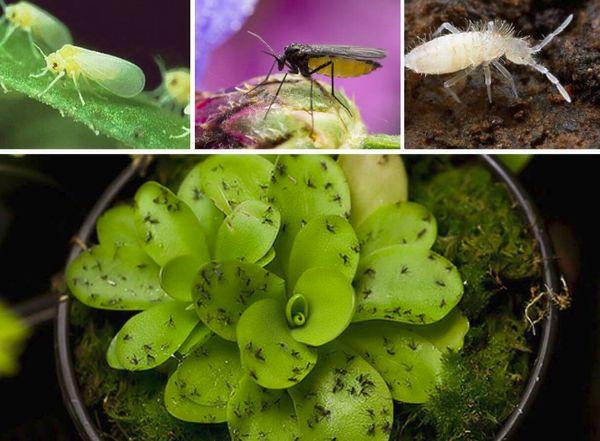
Moderate watering
In the process of caring for flowers, it is important to set the watering regime. Too much soil moisture is not recommended. Water the flower when the soil dries to a depth of 2.5 cm.
Good drainage
It will be possible to avoid stagnation of moisture in the pot thanks to the drainage layer. Before filling the soil into the pot, it is necessary to make holes at the bottom and fill a layer of stones. These measures will allow excess water to escape.
Soil loosening
Loose soil is less susceptible to the development of decay processes. Therefore, after each watering, it is recommended to loosen the soil, especially if the soil is dense.



